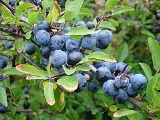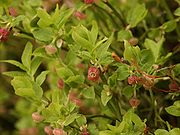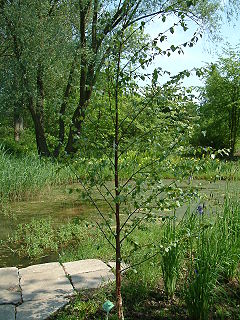
Traditional dyes of the Scottish Highlands
Encyclopedia
Traditional dyes of the Scottish Highlands are the
native vegetable dye
s used in Scottish Gaeldom.
The following are the principal dyestuffs with the colours they produce. Several of the tints are very bright, but have now been superseded by various mineral dyes. The Latin names are given where known and also the Scottish Gaelic
names for various ingredients. Amateurs may wish to experiment with some of the suggestions, but should note that urine
(human or animal) is used in many recipes as a mordant
. They should also note that a number of the recipes used are for more than one colour, and that this chart is only a guide, and also that Scottish Gaelic spelling is subject to variations.









The process employed is to wash the thread thoroughly in urine long kept ("fual"), rinse and wash in pure water, then put into the boiling pot of dye which is kept boiling hot on the fire. The thread is lifted now and again on the end of a stick, and again plunged in until it is all thoroughly dyed. If blue, the thread is then washed in salt water
but any other colour uses fresh water.
(Dath), with additions and corrections
native vegetable dye
Natural dye
Natural dyes are dyes or colorants derived from plants, invertebrates, or minerals. The majority of natural dyes are vegetable dyes from plant sources – roots, berries, bark, leaves, and wood — and other organic sources such as fungi and lichens....
s used in Scottish Gaeldom.
The following are the principal dyestuffs with the colours they produce. Several of the tints are very bright, but have now been superseded by various mineral dyes. The Latin names are given where known and also the Scottish Gaelic
Scottish Gaelic language
Scottish Gaelic is a Celtic language native to Scotland. A member of the Goidelic branch of the Celtic languages, Scottish Gaelic, like Modern Irish and Manx, developed out of Middle Irish, and thus descends ultimately from Primitive Irish....
names for various ingredients. Amateurs may wish to experiment with some of the suggestions, but should note that urine
Urine
Urine is a typically sterile liquid by-product of the body that is secreted by the kidneys through a process called urination and excreted through the urethra. Cellular metabolism generates numerous by-products, many rich in nitrogen, that require elimination from the bloodstream...
(human or animal) is used in many recipes as a mordant
Mordant
A mordant is a substance used to set dyes on fabrics or tissue sections by forming a coordination complex with the dye which then attaches to the fabric or tissue. It may be used for dyeing fabrics, or for intensifying stains in cell or tissue preparations. The term mordant comes from the Latin...
. They should also note that a number of the recipes used are for more than one colour, and that this chart is only a guide, and also that Scottish Gaelic spelling is subject to variations.
Claret
- Claret – "corcur" – a lichenLichenLichens are composite organisms consisting of a symbiotic organism composed of a fungus with a photosynthetic partner , usually either a green alga or cyanobacterium...
scraped off rocks and steeped in urineUrineUrine is a typically sterile liquid by-product of the body that is secreted by the kidneys through a process called urination and excreted through the urethra. Cellular metabolism generates numerous by-products, many rich in nitrogen, that require elimination from the bloodstream...
for three months, then taken out, made into cakes, and hung in bags to dry. When used these cakes are reduced to powder, and the colour fixed with alumAlumAlum is both a specific chemical compound and a class of chemical compounds. The specific compound is the hydrated potassium aluminium sulfate with the formula KAl2.12H2O. The wider class of compounds known as alums have the related empirical formula, AB2.12H2O.-Chemical properties:Alums are...
.
Black – Dubh

- Black (finest) –
- Common dock root with copperas.
- "Darach" – oakOakAn oak is a tree or shrub in the genus Quercus , of which about 600 species exist. "Oak" may also appear in the names of species in related genera, notably Lithocarpus...
bark and copperas - (also grey), "seileastair", irisIris (plant)Iris is a genus of 260-300species of flowering plants with showy flowers. It takes its name from the Greek word for a rainbow, referring to the wide variety of flower colors found among the many species...
root - "Sgitheach", hawthornCrataegusCrataegus , commonly called hawthorn or thornapple, is a large genus of shrubs and trees in the rose family, Rosaceae, native to temperate regions of the Northern Hemisphere in Europe, Asia and North America. The name hawthorn was originally applied to the species native to northern Europe,...
bark with copperas - AlderAlderAlder is the common name of a genus of flowering plants belonging to the birch family . The genus comprises about 30 species of monoecious trees and shrubs, few reaching large size, distributed throughout the North Temperate Zone and in the Americas along the Andes southwards to...
bark with copperas
- Blue-black
- Common sloe – Prunus spinosaPrunus spinosaPrunus spinosa is a species of Prunus native to Europe, western Asia, and locally in northwest Africa. It is also locally naturalised in New Zealand and eastern North America....
– "preas nan àirneag" - Red bearberryArctostaphylos uva-ursiArctostaphylos uva-ursi, with names for this species including Kinnikinnick and Pinemat manzanita, one of several related species referred to as Bearberry...
– Arbutus uva ursi, "grainnseag"
- Common sloe – Prunus spinosa
Blue – Gorm

- Blue
- Blaeberry (Vaccinum myrtillus) with alum or copperas
- ElderberryElderberrySambucus is a genus of between 5 and 30 species of shrubs or small trees in the moschatel family, Adoxaceae. It was formerly placed in the honeysuckle family, Caprifoliaceae, but was reclassified due to genetic evidence...
with alum - "Ailleann" elecampane
Brown – Donn

- Brown
- Common yellow wall lichenLichenLichens are composite organisms consisting of a symbiotic organism composed of a fungus with a photosynthetic partner , usually either a green alga or cyanobacterium...
– Parmelia parietina - Dark "crotal" (type of lichen) – Parmelia cetarophilia
- "Duileasg" (dulseDulsePalmaria palmata Kuntze, also called dulse, dillisk, dilsk, red dulse, sea lettuce flakes or creathnach, is a red alga previously referred to as Rhodymenia palmata Greville. It grows on the northern coasts of the Atlantic and Pacific oceans. It is a well-known snack food...
), a kind of seaweedSeaweedSeaweed is a loose, colloquial term encompassing macroscopic, multicellular, benthic marine algae. The term includes some members of the red, brown and green algae...
. - CurrantZante currantThe Zante currant , or currant are dried berries of small, sweet, seedless grape variety Black Corinth . The name comes from the Anglo-French phrase "raisins de Corinthe" and the Ionian island of Zakynthos , which was once the major producer and exporter...
with alum
- Common yellow wall lichen
- Dark chestnut-brown
- Roots of "rabhagach", the white water lily
- Dark brown
- Blaeberry with nut-galls
- Reddish brown - Ruadh
- The dark purple lichen ‘cen cerig cen du' (gun chéire gun dubh – i.e. neither crimson nor black) treated in the same way as the lichen for the claret dye.
- Philamot
- Yellowish "crotal" (type of lichen), the colour of dead leaves – Parmelia saxatilis
- Drab or fawn
- BirchBirchBirch is a tree or shrub of the genus Betula , in the family Betulaceae, closely related to the beech/oak family, Fagaceae. The Betula genus contains 30–60 known taxa...
barkBarkBark is the outermost layers of stems and roots of woody plants. Plants with bark include trees, woody vines and shrubs. Bark refers to all the tissues outside of the vascular cambium and is a nontechnical term. It overlays the wood and consists of the inner bark and the outer bark. The inner...
, Betula alba
- Birch
Green – Uaine

- Green
- Ripe privetPrivetPrivet was originally the name for the European semi-evergreen shrub Ligustrum vulgare, and later also for the more reliably evergreen Ligustrum ovalifolium , used extensively for privacy hedging. It is often suggested that the name privet is related to private, but the OED states that there is no...
berries with saltSaltIn chemistry, salts are ionic compounds that result from the neutralization reaction of an acid and a base. They are composed of cations and anions so that the product is electrically neutral...
(listed for crimson too) - Wild Mignonette (Reseda), reseda luteola, "lus buidhe mòr", with indigo
- "Rùsg conuisg", whin bark
- Cow weed
- Ripe privet
- "Lively" green
- Common broom
- Dark green
- Heather, Erica cinera, "fraoch bhadain" with alum. The heather must be pulled before flowering and from a dark, shady place.
- Iris leaf ("Duilleag seileisteir")
Orange – Orains/Dearg-buidhe

- Orange
- Ragweed ("Stinking Billy") – Senecio jacobaea, "buaghallan"
- Barberry root –berberis vulgarisBerberis vulgarisBerberis vulgaris /// is a shrub in the family Berberidaceae, native to central and southern Europe, northwest Africa and western Asia; it is also naturalised in northern Europe, including the British Isles and Scandinavia, and North America.It is a deciduous shrub growing up to 4 m high...
, "barbrag"
- Dark orange
- BrambleBrambleBrambles are thorny plants of the genus Rubus, in the rose family . Bramble fruit is the fruit of any such plant, including the blackberry and raspberry. The word comes from Germanic *bram-bezi, whence also German Brombeere , Dutch Braam and French framboise...
–Rubus fructicosus, "preas smeur"
- Bramble
Purple – Corcair/Purpaidh

- Purple
- EuonymusEuonymusEuonymus , often called spindle or spindle tree, is a genus of flowering plants in the staff vine family, Celastraceae. It comprises about 170–180 species of deciduous and evergreen shrubs and small trees...
(Spindle tree), with sal-ammoniac - SundewSundewDrosera, commonly known as the sundews, comprise one of the largest genera of carnivorous plants, with at least 194 species. These members of the family Droseraceae lure, capture, and digest insects using stalked mucilaginous glands covering their leaf surface. The insects are used to supplement...
– Drosera rotundifoliaDrosera rotundifoliaDrosera rotundifolia is a species of sundew, a carnivorous plant often found in bogs, marshes and fens...
, "lus-na-feàrnaich" - Blaeberry – Vaccinium myrtilis, with alum
- Euonymus
Red – Dearg

- Red
- TormentilTormentilCommon Tormentil is a herbaceous perennial belonging to the rose family , also known as Septfoil or simply as "tormentil" .-Characteristics:It is a low, clumb-forming plant with slender, procumbent...
– Potentilla tormentilla, "leanartach" - Rock lichen – Ramalina scopulorum, "cnotal"
- White "cnotal" – Lecanora pallacens, "cnotal geal"
- Tormentil
- Fine red
- RueRueRue is a genus of strongly scented evergreen subshrubs 20–60 cm tall, in the family Rutaceae, native to the Mediterranean region, Macaronesia and southwest Asia. There are perhaps 8 to 40 species in the genus...
– Gallium virum, "ladies' bedstraw". A very fine red is obtained from this. Strip the bark off the roots, then boil them in water to extract the remainder of the virtue, then take the roots out and put the bark in, and boil that and the yarn together, adding alum to fix the colour. - Gallium boreale – treated in the same way as gallium virum above.
- Rue
- Purple-red
- Blaeberry – Vaccinium myrtilis, lus-nan-dearc, with alum, verdigrisVerdigrisVerdigris is the common name for a green pigment obtained through the application of acetic acid to copper plates or the natural patina formed when copper, brass or bronze is weathered and exposed to air or seawater over a period of time. It is usually a basic copper carbonate, but near the sea...
and sal-ammoniac
- Blaeberry – Vaccinium myrtilis, lus-nan-dearc, with alum, verdigris
- Crimson
- "Cnotal corcur" – Lecanora tartarea, white and ground with urine. This was once in favour for producing a bright crimson dye.
- Scarlet
- LimestoneLimestoneLimestone is a sedimentary rock composed largely of the minerals calcite and aragonite, which are different crystal forms of calcium carbonate . Many limestones are composed from skeletal fragments of marine organisms such as coral or foraminifera....
lichen – Urceolaria calcaria, "Cnotal clach-aoil" – used by the peasantry in limestone districts, such as Shetland. - Ripe privet berries with salt. (Listed for green too!)
- Limestone
Violet

- Violet
- Wild cressWatercressWatercresses are fast-growing, aquatic or semi-aquatic, perennial plants native from Europe to central Asia, and one of the oldest known leaf vegetables consumed by human beings...
– NasturtiumNasturtiumTropaeolum , commonly known as Nasturtium literally "nose-twister" or "nose-tweaker"), is a genus of roughly 80 species of annual and perennial herbaceous flowering plants and the only genus in the family Tropaeolaceae...
officinalis "biolair" - Bitter vetch – Lathyrus tuberosusLathyrus tuberosusLathyrus tuberosus, also known as the Tuberous Pea, Tuberous Vetchling, Earthnut Pea, or Aardaker, is a small, climbing perennial plant, native in moist temperate parts of Europe and Western Asia....
-- cairmeal - BilberriesBilberryBilberry is any of several species of low-growing shrubs in the genus Vaccinium , bearing edible berries. The species most often referred to is Vaccinium myrtillus L., but there are several other closely related species....
fixed with alum
- Wild cress
Yellow – Buidhe

- Yellow
- AppleAppleThe apple is the pomaceous fruit of the apple tree, species Malus domestica in the rose family . It is one of the most widely cultivated tree fruits, and the most widely known of the many members of genus Malus that are used by humans. Apple grow on small, deciduous trees that blossom in the spring...
-tree, ashAsh treeFraxinus is a genus flowering plants in the olive and lilac family, Oleaceae. It contains 45-65 species of usually medium to large trees, mostly deciduous though a few subtropical species are evergreen. The tree's common English name, ash, goes back to the Old English æsc, while the generic name...
and buckthorn - PoplarPoplarPopulus is a genus of 25–35 species of deciduous flowering plants in the family Salicaceae, native to most of the Northern Hemisphere. English names variously applied to different species include poplar , aspen, and cottonwood....
and elmElmElms are deciduous and semi-deciduous trees comprising the genus Ulmus in the plant family Ulmaceae. The dozens of species are found in temperate and tropical-montane regions of North America and Eurasia, ranging southward into Indonesia. Elms are components of many kinds of natural forests... - Bog myrtle, Roid
- Ash roots
- TeazleTeazleTeazle is a Swedish computer game from Aniware AB. The game features many mini-games, which have high-score pages which are saved online. Another version is Teazle 2. Some mini games are: Mini-Golf, Duck-n-run, Slime Attack, Pool, GoCart, English Park. The game is for Windows 95 to Windows Vista....
– Dipsacus fullonumDipsacus fullonumDipsacus fullonum, syn. Dipsacus sylvestris, is a species of flowering plant known by the common names Fuller's teasel and wild teasel. It is native to Eurasia and North Africa, but it is known in the Americas, southern Africa, Australia and New Zealand as an introduced species and often a noxious...
– lùs-an-fhùcadair/leadan - Bracken roots – Raineach mhòr
- Cow weed
- Tops and flowers of heather, Erica, fraoch
- Wild mignonetteMignonetteMignonette is a genus of fragrant herbaceous plants native to the Mediterranean region and southwest Asia, from the Canary Islands and Iberia east to northwest India. The species include annuals, biennials and perennials, and grow to 40-130 cm tall...
, reseda luteola, "lus buidhe mòr", dried, reduced to powder and boiled. - Leaves and twigs of dwarf birchDwarf BirchBetula nana is a species of birch in the family Betulaceae, found mainly in the tundra of the Arctic region.-Description:...
, beithe beag
- Apple
- Bright yellow
- SundewSundewDrosera, commonly known as the sundews, comprise one of the largest genera of carnivorous plants, with at least 194 species. These members of the family Droseraceae lure, capture, and digest insects using stalked mucilaginous glands covering their leaf surface. The insects are used to supplement...
– Drosera rotundifoliaDrosera rotundifoliaDrosera rotundifolia is a species of sundew, a carnivorous plant often found in bogs, marshes and fens...
, "lus-na-feàrnaich" with ammonia
- Sundew
- Rich Yellow
- St John's WortSt John's wortSt John's wort is the plant species Hypericum perforatum, and is also known as Tipton's Weed, Chase-devil, or Klamath weed....
, achlasan Chalum cille, fixed with alum
- St John's Wort
- Dirty yellow
- PeatPeatPeat is an accumulation of partially decayed vegetation matter or histosol. Peat forms in wetland bogs, moors, muskegs, pocosins, mires, and peat swamp forests. Peat is harvested as an important source of fuel in certain parts of the world...
sootSootSoot is a general term that refers to impure carbon particles resulting from the incomplete combustion of a hydrocarbon. It is more properly restricted to the product of the gas-phase combustion process but is commonly extended to include the residual pyrolyzed fuel particles such as cenospheres,...
. Obviously this ingredient on its own will not produce yellow - RhubarbRhubarbRhubarb is a group of plants that belong to the genus Rheum in the family Polygonaceae. They are herbaceous perennial plants growing from short, thick rhizomes. They have large leaves that are somewhat triangular-shaped with long fleshy petioles...
, (monk's) – Rymex alpinus – lus na purgaid
- Peat
The process employed is to wash the thread thoroughly in urine long kept ("fual"), rinse and wash in pure water, then put into the boiling pot of dye which is kept boiling hot on the fire. The thread is lifted now and again on the end of a stick, and again plunged in until it is all thoroughly dyed. If blue, the thread is then washed in salt water
Brine
Brine is water, saturated or nearly saturated with salt .Brine is used to preserve vegetables, fruit, fish, and meat, in a process known as brining . Brine is also commonly used to age Halloumi and Feta cheeses, or for pickling foodstuffs, as a means of preserving them...
but any other colour uses fresh water.
(Dath), with additions and corrections
External links
Further reading
- Fraser, Jean: Traditional Scottish Dyes, Canongate, 1983, ISBN 0-8624-1108-4

